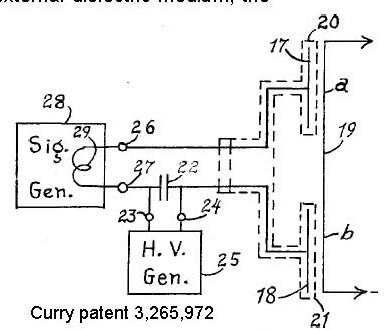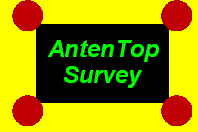


Antentop is FREE e-magazine devoted to Antennas and Amateur Radio an
Special page devoted to
The Underwater Communication System

Custom Search
|
ANTENTOP-
03- 2003, # 004 |
The Underwater Communication
System
|
|
|
|
|
|
|
|
To
differentiate Tesla's wireless method from contemporary understanding
of the technique, and from the misunderstandings arising from
the chronology of Tesla's research into the nature of electrical
communication, his method can be contrasted with modern patents
for electrostatic submarine communication and the inventor's earlier
work in this field. Contemporary Patents L.
Gilstrap's patent for an Electrostatic Communication System, #3,964,051, issued June 15,
1976, describes a device consisting of two concentric conducting
spheres (#26 & #28) separated by a dielectric layer to form
a monopole radiator for electrostatic waves. |
 |
|
Gilstrap
patent 3,964,051
|
Curry states:
The antenna
system for an electromagnetic emission into space circulates energy
in accordance with the laws governing electrical current in motion.
Since the field strength produced by an antenna is proportional
to the alternating currents circulating in it, its optimum structural
relationships are directed to a reduction of the total antenna
resistance, thus to increase the total current for a given power
input to a radiator.13 He adds: Being
a current-actuated device, such an [electromagnetic] antenna will not operate in any physical conducting
medium such as |
|
|
|
|
The
patent states that "longitudinal electrostatic or capacitive
waves, also called scalar or polarization waves because of their
relationship to the Maxwell wave equations" are the means
of propagation but the patent does not explain how these waves
differ from conventional forms of electromagnetic radiation. It
simply states that as the spheres are subject to voltages of opposite
polarity the "outer sphere then appears as an ideal monopole
radiator to the external dielectric medium, in this case water."12 In this configuration, electric field is confined to the region between the two conducting spheres of the transmitter. Little energy, if any, is available to stress the external dielectric medium, the water. P. Curry's
patent for an Underwater Electric Field Communica-tion
System, #3,265,972, issued August 9, 1966 proposes a ra-diator
of a different configuration and presents a detailed discus-sion of communication by electrostatic induction. |
While
a radiator for electromagnetic emission produces its field strength
by the effect of changing currents; the radiator for electrostatic
emission of the type here to be described produces its field strength
by the effect of changing potentials.15 Curry proposes "the electrical potentials of the signal to be transmitted to two equal metal plates (#17 & #18) each of which is hermetically sealed within insulating material (#20 & #21)... immersed in a conducting fluid such as sea water."16 By
applying a varying potential to the plates of the radiator, charge
of opposite polarity accumulates on the two plates such that a
charge gradient exists in the region between the radiators. The
patent explains: |
|
|
|
|
Page 32 |
|
 |
 |
 |
 |
Just for Fun:

Powered byIP2Location.com
Thanks for your time!
Last Updated:
March 1, 2020 19:34





